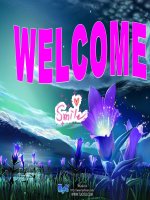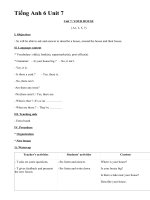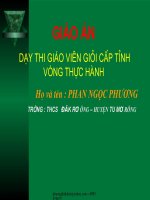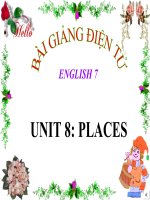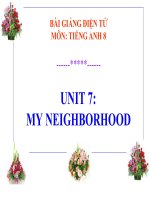Giáo án Tiếng anh 7 unit 7
Bạn đang xem bản rút gọn của tài liệu. Xem và tải ngay bản đầy đủ của tài liệu tại đây (2.29 MB, 48 trang )
School: ………………………………………..
Class: …………………………….....................
Date: ……………………………..
Period: ………………………......
UNIT 7: TRANSPORTATION
Lesson 1.1 – New words and Listening (page 52)
I. OBJECTIVES
By the end of the lesson, Ss will be able to:
1.1. Language knowledge and skills
- know more words relating to personal belongings and places in the airport (luggage, boarding pass,
backpack, suitcase, passport, customs, baggage claim).
- describe and identify personal belongings.
- listen to and understand a conversation of two people in an airport (for general and specific details).
- know how to ask for confirmation.
1.2. Competences
- improve communication, collaboration, and critical thinking skills.
1.3. Attributes
- take care of personal belongings.
- carefully prepare for any trip.
II. TEACHING AIDS AND LEARNING MATERIALS
1. Teacher’s aids: Student book and Teacher’s book, class CDs, Digital Book (DCR phần mềm tương
tác SB, DHA (từ vựng/ cấu trúc) phần mềm trò chơi tương tác), projector/interactive whiteboard / TV
(if any), PowerPoint slides.
2. Students’ aids: Student’s book, workbook, notebook.
III. ASSESSMENT EVIDENCE
Performance Tasks
Performance Products
Assessment Tools
- Number the pictures.
- Ss’ answers.
- T’s feedback/Peers’ feedback.
- Listen and repeat.
- Ss’ presentation.
- T’s feedback/Peers’ feedback.
- Discuss adjectives you could
use for these items: suitcase,
backpack, and luggage.
- Ss’ presentation / answers.
- T’s feedback/Peers’ feedback.
- Listen to Jenny and Fred at the
airport. What are they doing?
- Ss’ answers.
- T’s feedback/Peers’ feedback.
- Listen and fill in the blanks.
- Ss’ answers.
- T’s feedback/Peers’ feedback.
- Speak: What type of luggage
- Ss’ answers/ presentation.
- T’s observation and feedback.
do you like to travel with? Why?
IV. PROCEDURES
A. Warm up: (5’)
a) Objective: Introduce the new lesson and set the scene for Ss to acquire new language; get
students' attention at the beginning of the class by enjoyable and short activities as well as to engage
them in the follow-up steps.
b) Content: Introduce words about personal belongings.
c) Expected outcomes: Ss get to know some new words they are going to study in the lesson.
d) Organization of the activity:
TEACHER’S ACTIVITIES
Option 1: Number the pictures. Listen and repeat.
- Use the “New words” part a– page 52 for the warm-up
activity.
- Show words and pictures using DCR, have Ss look and
number the pictures (in pairs).
- Call Ss to give answers.
- Give feedback and show correct answers using DCR.
- Lead to the new lesson.
- Play the audio (CD1 – Track 69), have Ss listen and
repeat.
- Correct Ss’ pronunciation if necessary.
Option 2:
- Divide class into 4-5 groups.
- Have Ss work in groups to list things people often need
when they travel abroad (in about 1-2 minutes).
- Have a representative in each group write answers on
the board.
- Check Ss’s answers and give feedback.
- The group with the most correct answers will be the
winner.
- Lead to the new lesson.
STUDENTS’ ACTIVITIES
- Work in pairs to number the pictures.
- Give answers.
- Listen.
- Listen and repeat.
Answer keys
- Take part in the class’s activity.
- Write answers.
- Listen.
Suggested answers: passport, luggage,
boarding pass, headphone, earphone,
backpack, phone and device chargers, daily
medication, clothes, water,…
B. New lesson (35’)
Activity 1: Pre-Listening (Vocabulary) (12’)
a) Objective: Ss get to know words about personal belongings.
b) Content:
- Vocabulary study (luggage, boarding pass, backpack, suitcase, passport, customs, baggage claim).
- Speaking: Discuss adjectives you could use for these items: suitcase, backpack, and luggage.
c) Expected outcomes: Ss know how to pronounce the new words correctly and use them when they
do some listening tasks.
d) Organization of the activity:
TEACHER’S ACTIVITIES
STUDENTS’ ACTIVITIES
Task a. Number the pictures. Listen and repeat.
Option 1 (If the teacher hasn’t used this part for
the Warm-up activity.)
- Demonstrate the activity on DCR, using the
- Look and listen.
example.
- Work individually.
- Have Ss number the pictures.
- Divide class into pairs and have them check their
- Work in pairs.
answers with their partners.
- Give answers.
- Call Ss to give answers.
- Check answers as a whole class using DCR.
- Listen and repeat.
- Play audio (CD1 – Track 69). Have Ss listen and
Answer keys
repeat.
- Correct Ss’ pronunciation.
Option 2: (If the teacher has used part a for the
warm-up activity.)Matching
- Have Ss match the words they have known in Task a
(from Warm up activity) by matching words with their
definitions.
- Have Ss give answers and tell the meaning of
words / phrases again.
- Check answers as a whole class.
- Call some Ss to read the words again.
- Correct Ss’ pronunciation if necessary.
*Illustration:
- Work in pairs.
- Give answers, meaning.
- Read.
Answer keys
1g
2d
3f
4a
5b
6e
7c
Task b. In pairs: Discuss adjectives you could use
for these items: suitcase, backpack, and luggage.
- Have Ss work in pairs to discuss adjectives they
could use for these items: suitcase, backpack, and
luggage.
- Go round and give help if necessary.
- Have some pairs demonstrate the activity in front of
the class.
- Give feedback and evaluation.
- Work in pairs to discuss.
- Present.
Sample answers
Activity 2: While - Listening (17’)
a) Objective: Students can develop their listening skill.
b) Content:
- Listen to Jenny and Fred at the airport. What are they doing?
- Listen and fill in the blanks.
c) Expected outcomes: Ss can listen to and understand a conversation of two people in an airport (for
general and specific details).
d) Organization of the activity:
TEACHER’S ACTIVITIES
STUDENTS’ ACTIVITIES
Task a. Listen to Jenny and Fred at the airport.
What are they doing?
- Have Ss read the question, guess the answer.
- Play audio (CD1 - Track 70).
- Have Ss listen and circle the correct answer.
- Check answers as a whole class using DCR.
-Work individually.
- Listen.
- Circle the correct answers.
Answer keys
Task b. Now, listen and fill in the blanks
- Have Ss read the through the content of Task b,
underline the key words.
- Play the audio again (CD1 - Track 70).
- Read, underline the key words.
- Have Ss listen and fill in the blanks.
- Have Ss check answers with their partners.
- Call Ss to give answers.
- Give feedback and show correct answers using
DCR.
- Do the task.
- Exchange answers.
Answer keys
Activity 3: Post - Listening (6’)
a) Objective: Students can use the vocabulary and the content in listening part to develop their
speaking skill.
b) Content: Speaking: What type of luggage do you like to travel with? Why?
c) Expected outcomes: Students can talk about their personal belongings for travelling.
d) Organization of the activity:
TEACHER’S ACTIVITIES
Conversation skill
- Have Ss look at the Conversation skill box and
read (using DCR).
- Play audio (CD 1 - Track 71), have Ss listen and
repeat.
- Ask Ss to find more ways to ask for confirmation.
STUDENTS’ ACTIVITIES
- Look and read.
- Listen and repeat.
- Give answers.
Task c. In pairs: What type of luggage do you
like to travel with? Why?
- Have Ss work in pairs to discuss.
- Observe and give help if necessary.
- Call some pairs to share their ideas with the class
- Give feedback and evaluation.
- Work in pairs.
- Present.
C. Consolidation and homework assignments (5’)
* Consolidation:
- Words relating to personal belongings and places in the airport. (luggage, boarding pass,
backpack, suitcase, passport, customs, baggage claim…).
- Language for asking for confirmation: Did you say …? / Was that …?
* Homework
- Learn the new words by heart.
- Practice talking about things you need when traveling abroad.
- Do the exercises in WB: New words and Listening (page 38).
- Do the vocabulary exercise in Tiếng Anh 7 i-Learn Smart World Notebook (page 42).
- Play consolation games in Tiếng Anh 7 i-Learn Smart World DHA App on www.eduhome.com.vn
- Prepare: Lesson 1.2 – Grammar (page 53 – SB).
D. Reflection
a. What I liked most about this lesson today:
…………………………………………………………………………………………
b. What I learned from this lesson today:
…………………………………………………………………………………………
c. What I should improve for this lesson next time:
…………………………………………………………………………………………
School: ………………………………………..
Class: …………………………….....................
Date: ………………………………..
Period: ………………………….........
UNIT 7: TRANSPORTATION
Lesson 1.2 - Grammar (page 53)
I. OBJECTIVES
By the end of the lesson, Ss will be able to:
1.1. Language knowledge and skills
- listen to 2 people asking and answering about personal belongings.
- use order of adjectives and possessive pronouns correctly.
- describe their own personal belongings and others’.
1.2. Competences
- improve speaking, listening skills.
- improve the use of English.
1.3. Attributes
- take care of personal belongings.
- carefully prepare for any trip.
II. TEACHING AIDS AND LEARNING MATERIALS
1. Teacher’s aids: Student book and Teacher’s book, class CDs, Digital Book (DCR phần mềm tương
tác SB, DHA (từ vựng/ cấu trúc) phần mềm trò chơi tương tác), projector/interactive whiteboard / TV
(if any), PowerPoint slides, handouts.
2. Students’ aids: Student’s book, workbook, notebook, handouts.
III. ASSESSMENT EVIDENCE
Performance Tasks
Performance Products
Assessment Tools
- Listen and repeat.
- Study the grammar box.
- Fill in the blanks with the
correct order of adjectives.
- Fill in the blanks with the
correct possessive pronouns to
complete the conversation.
- Speak: Ask your partner
about the luggage. Use the
prompts.
- Ss’ performance.
- Ss’ answers/ presentation.
- Ss’ answers.
- Ss’ answers.
- Ss’ answers/ presentation.
- T’s feedback.
- T’s feedback.
- T’s feedback/Peers’
feedback.
- T’s feedback/Peers’
feedback.
- T’s observation, T’s
feedback/Peers’ feedback.
IV. PROCEDURES
A. Warm up: (5’)
a) Objective: Introduce the new lesson and set the scene for Ss to acquire new language; get
students' attention at the beginning of the class by enjoyable and short activities as well as to engage
them in the follow-up steps.
b) Content: Review words about personal belongings / Review adjectives to describe things.
c) Expected outcomes: Ss review old words which are very useful for them in the new lesson.
d) Organization of the activity:
TEACHER’S ACTIVITIES
Option 1:
- Have Ss close books and notebooks.
- Have Ss look at the pictures and give names of
personal belongings.
- Call Ss to give answers.
- Check Ss’ answers, give feedback.
- Have Ss make sentences, using the words they have
just made.
- Lead to the new lesson.
STUDENTS’ ACTIVITIES
- Close books and notebooks.
- Work in pairs.
- Give answers.
- Make sentences.
Answers keys
1. suitcase
2. backpack
3. boarding pass
4. passport
5. baggage claim
6. luggage
Option 2: Adjectives to describe things
- Have Ss close all books and notebooks.
- T uses pictures or cards.
- Close books and notebooks.
- Have Ss look at the pictures (or take cards) and divide
them into 3 categories: size, color, age.
- Call Ss to give answers.
- Check Ss’ answers, give feedback.
- Lead to the new lesson.
*Illustration
- Work in groups.
- Give answers.
- Listen and write the new lesson.
Answers keys
B. New lesson (35’)
Activity 1: Presentation (10’)
a) Objective: Introduce: “order of adjectives” and “possessive pronouns”.
b) Content:
- Listen and repeat.
- Introduce the grammar points.
c) Expected outcomes: Ss know the new grammar points “order of adjectives” and “possessive
pronouns” and use them in some exercises that follow.
d) Organization of the activity:
TEACHER’S ACTIVITIES
STUDENTS’ ACTIVITIES
Task a. Listen and repeat
- Have Ss look at the picture using DCR.
- Look.
- Play audio (CD1 – Track 72) and have Ss listen and
- Listen, then read.
read the speech bubbles.
- Play the audio again and have Ss listen and repeat.
- Listen and repeat.
Grammar box
Option 1:
- Have Ss look at the grammar explanation and read:
Order of adjectives.
- Look and read.
- Have Ss look at the grammar explanation and read:
Possessive Pronouns.
- Have Ss read the examples:
- Read examples of different forms.
- Explain more about “order of adjectives” and
“possessive pronouns”.
- Ask Ss to make more sentences using “order of
adjectives” and “possessive pronouns”.
- Give feedback and evaluation.
Option 2:
- Have Ss look at the sentences in the speech bubbles
in Task a and read them again.
- Have Ss make comments on the words in bold
(mine / dark blue).
- Ask Ss some questions:
1 What do you think “mine” means?
2 What does it replace?
3 Why do they write “dark blue”, not “blue dark”?
- Call Ss to give answers and give feedback.
- Then, lead to the grammar box, briefly explain the
way to use “order of adjectives” and “possessive
pronouns”.
- Have Ss read the grammar box and examples.
- Listen.
- Give more examples.
- Look and read.
- Comment.
Expected answers
1. It means: “của tôi” (something that
belongs to me).
2. It replaces “my suitcase”.
3. Ss’ answers.
- Read.
- Give more examples.
- Ask Ss to make more sentences using “order of
adjectives” and “possessive pronouns”.
- Give feedback and evaluation.
- Listen.
Activity 2: Practice (19’)
a) Objective: Students can use “order of adjectives” and “possessive pronouns” to do the given
exercises.
b) Content:
- Fill in the blanks with the correct order of adjectives.
- Fill in the blanks with the correct possessive pronouns to complete the conversation.
c) Expected outcomes: Students can get used to the usage of “order of adjectives” and “possessive
pronouns” and use them correctly.
d) Organization of the activity:
TEACHER’S ACTIVITIES
Task b. Fill in the blanks with the correct order of
adjectives.
- Demonstrate the activity on DCR, using the
example.
- Have Ss fill in the blanks with the correct order of
adjectives.
- Have Ss work in pairs to check each other’s work.
- Have some Ss share their answers with the whole
class.
STUDENTS’ ACTIVITIES
- Look and listen.
- Work individually.
- Work in pairs.
- Write answers.
Answer keys
- Give feedback, correct Ss’ answers if necessary.
Task c. Fill in the blanks with the correct
possessive pronouns to complete the conversation.
- Demonstrate the activity on DCR using the
example.
- Look and listen.
- Have students fill in the blanks with the correct
possessive pronouns to complete the conversation.
- Work individually.
- Have pairs check each other's work.
- Have some students share their answers with the
class.
- Work in pairs.
- Read answers, explain.
Answer keys
Activity 3: Production (6’)
a) Objective: Students master the grammar points they study in the lesson.
b) Content: Speaking: Ask your partner about the luggage. Use the prompts.
c) Expected outcomes: Ss produce the new language successfully, and they can use the grammar point
in the lesson in everyday speaking and writing.
d) Organization of the activity:
TEACHER’S ACTIVITIES
Task d. In pairs: Ask your partner about the
luggage. Use the prompts.
- Divide class into pairs.
- Have Ss take turns asking their partner about the
luggage. Use the prompts.
- Have some pairs demonstrate the activity in front
of the class.
- Give feedback and evaluation.
STUDENTS’ ACTIVITIES
- Have conversation in pairs.
- Present.
- Listen.
Suggested answers
C. Consolidation and homework assignments (5’)
* Consolidation:
* Homework:
- Make 2 sentences, use “order of adjectives” and “possessive pronouns”.
- Do the exercises in WB: Grammar and Writing (page 39).
- Complete the grammar notes in Tiếng Anh 7 i-Learn Smart World Notebook (page 43).
- Play consolation games in Tiếng Anh 7 i-Learn Smart World DHA App on www.eduhome.com.vn
- Prepare: Lesson 1.3 – Pronunciation and Speaking (page 54 – SB).
D. Reflection
a. What I liked most about this lesson today:
…………………………………………………………………………………………
c. What I learned from this lesson today:
…………………………………………………………………………………………
c. What I should improve for this lesson next time:
…………………………………………………………………………………………
School: ………………………………………..
Class: …………………………….....................
Date: …………………………………..
Period: ………………………….........
UNIT 7: TRANSPORTATION
Lesson 1.3 – Pronunciation and Speaking (page 54)
I. OBJECTIVES
By the end of the lesson, Ss will be able to:
1.1. Language knowledge and skills
- distinguish and put stress on the first syllable for most two-syllable nouns.
- describe luggage.
- talking about collecting luggage at the baggage claim.
1.2. Competences
- improve listening and speaking skills.
1.3. Attributes
- take care of personal belongings.
- carefully prepare for any trip.
II. TEACHING AIDS AND LEARNING MATERIALS
1. Teacher’s aids: Student book and Teacher’s book, class CDs, Digital Book (DCR phần mềm tương
tác SB, DHA (từ vựng/ cấu trúc) phần mềm trò chơi tương tác), projector/interactive whiteboard / TV
(if any), PowerPoint slides, handouts.
2. Students’ aids: Student’s book, workbook, notebook, paper, colored pencils (crayons), rubbers.
III. ASSESSMENT EVIDENCE
Performance Tasks
Performance Products
Assessment Tools
- Listen to the words and focus
on the underlined letters.
- Ss’ performance and
answers.
- T’s observation.
- Listen and cross out the word
that doesn’t follow the note in
“a”.
- Ss’ answers.
- T’s feedback/Peers’
feedback.
- Read the words with the stress
changes noted in “a” with a
partner.
- Ss’ performance.
- T’s feedback/Peers’
feedback.
- Point, ask and answer.
- Ss’ performance.
- T’s feedback/Peers’
- You're at the baggage claim
collecting your friends' luggage.
In pairs: Student B, turn to page
120, File 6. Student A, ask
which luggage your friends
have. Point and guess. Then,
number the boxes.
- Ss’ performance /
Presentation.
- Swap roles and repeat. Student - Ss’ performance /
A, turn to page 121, File 7.
Answers.
Student B, ask which luggage
their friends have. Point and
guess. Then, number the boxes.
feedback.
- T’s observation, T’s
feedback/Peers’ feedback.
- T’s feedback/Peers’
feedback.
IV. PROCEDURES
A. Warm up: (5’)
a) Objective: Introduce the new lesson and set the scene for Ss to acquire new language; get
students' attention at the beginning of the class by enjoyable and short activities as well as to engage
them in the follow-up steps.
b) Content: Vocabulary: Nouns with two syllables / Chinese whisper.
c) Expected outcomes: Ss remember old knowledge and use them in other speaking activities.
d) Organization of the activity:
TEACHER’S ACTIVITIES
Option 1: Nouns with two syllables
- Have Ss close all books.
- Divide Ss into 4 groups.
- Have Ss work in groups to write nouns with 2 syllables
as many as possible.
- Call Ss to write answers on the boards.
- Check Ss’ answers, give feedback and announce the
winning group.
- Lead to the new lesson: How to put stress on most twosyllable nouns.
Option 2: Chinese whisper
- Divide class into 4-5 groups.
- Have Ss in each group stand in a straight line.
- Give a sentence, have the last student in each line
whisper this sentence to the student standing before;
continue until the first student in the line can hear the
sentence and write it on the board.
- Check Ss’ answers.
- The group which has the closest sentence to the
original one will be the winner (T also checks spelling).
STUDENTS’ ACTIVITIES
- Close all books.
- Work in groups, then give answers.
Suggested answers
Nouns with two syllables: passport,
luggage, candy, backpack, suitcase, airport,
ticket, paper, lesson, teacher, doctor,
partner, ruler, custom, people, …
- Form groups.
- Work in groups to take part in the game.
- The first student of each line writes
answer on the board.
- Announce the winner and give a small present.
- Lead to the new lesson.
*Suggested sentence: I have a dark blue backpack and
a big old pink suitcase.
- Listen.
B. New lesson (35’)
Activity 1: Pre-Speaking: Pronunciation (8’)
a) Objective: Introduce: stress on most two-syllable nouns.
b) Content:
- recognize: stress on most two-syllable nouns.
- listen and check, find the word that doesn’t follow the note in “a”.
- practice.
c) Expected outcomes: Ss distinguish and put stress on most two-syllable nouns correctly in their
speaking.
d) Organization of the activity:
TEACHER’S ACTIVITIES
STUDENTS’ ACTIVITIES
Task a + b. Listen to the words and focus on the
underlined letters.
- Listen.
- Play the recording (CD1, track 73).
- Ask Ss to listen and focus on the underlined letters.
- Play the recording again, have Ss listen and repeat
- Listen again and repeat.
with a focus on the stress feature.
Task c + d. Listen and cross out the word that
doesn’t follow the note in “a”.
- Play the recording (CD 1 – Track 74), have Ss listen
and cross out the option that doesn’t follow the note in
“a”.
- Call Ss to give answers.
- Play the recording again and check answers as a
whole class using DCR.
- Give feedback and evaluation.
- Listen and give answers.
Answer keys
Activity 2: While-speaking (22’)
a) Objective: Students can describe luggage.
b) Content:
- Point, ask and answer.
- You're at the baggage claim collecting your friends' luggage. In pairs: Student B, turn to page 120,
File 6. Student A, ask which luggage your friends have. Point and guess. Then, number the boxes.
- Swap roles and repeat. Student A, turn to page 121, File 7. Student B, ask which luggage their friends
have. Point and guess. Then, number the boxes.
c) Expected outcomes: Ss produce the new language successfully.
d) Organization of the activity:
TEACHER’S ACTIVITIES
PRACTICE
* Point, ask and answer.
- Demonstrate the activity on DCR using the example.
STUDENTS’ ACTIVITIES
- Observe, listen.
- Work in pairs.
- Divide the class into pairs.
- Have pairs point, ask and answer about luggage.
- Observe, give help if necessary.
- Remind Ss to use language of asking for confirmation.
- Have some pairs demonstrate the activity in front of
the class.
- Give feedback and evaluation.
SPEAKING: That’s Not My Bag!
Task a. You're at the baggage claim collecting your
friends' luggage. In pairs: Student B, turn to page
120, File 6. Student A, ask which luggage your
friends have. Point and guess. Then, number the
boxes.
- Demonstrate the activity by practicing the role-play
with a student.
- Divide the class into pairs.
- Have Student B turn to page 120, File 6.
- Have Student A ask which luggage their friends have
and Student B answer.
- Have Student A number the boxes.
- Observe, give help if necessary.
Task b. Swap roles and repeat. Student A, turn to
page 121, File 7. Student B, ask which luggage their
friends have. Point and guess. Then, number the
boxes.
- Have Student A turn to page 121, File 7 and Student B
turn back to page 54.
- Swap roles and repeat.
- Have some pairs demonstrate the activity in front of
the class.
- Present.
- Observe and listen.
- Work in pairs.
- Student A number the boxes.
Examples
- Work in pairs.
- Swap roles and repeat.
- Present.
Activity 3: Production (5’)
a) Objective: Students relax after the lesson.
b) Content: Drawing: Draw luggage.
c) Expected outcomes: Ss produce the new language successfully in everyday speaking and writing
and develop their drawing skill.
d) Organization of the activity:
TEACHER’S ACTIVITIES
Extra activity: Draw luggage.
- Have a student describe a kind of luggage (of his /
her own or others’).
- Have 5 Ss volunteers to listen and draw that kind
of luggage as described on the board.
- Check Ss’ drawings and give feedback.
- Have class vote for the best picture.
- Announce the winner.
STUDENTS’ ACTIVITIES
- 1 student describes a kind luggage (a
suitcase, a bag, a backpack, …).
- Listen and draw.
- Listen.
Sample description
I have a big old blue backpack. It has an
elephant on it. There are also some heart
symbols on it, …
Sample drawing / picture
C. Consolidation and homework assignments (5’)
* Consolidation: stress on the first syllable for most two-syllable nouns.
* Homework:
- Practice: stress on the first syllable for most two-syllable nouns.
- Find more nouns with 2 syllables and practice pronouncing them.
- Prepare: Unit 7 - Lesson 2 – New words and Reading (page 55 – SB).
- Review the vocabulary and grammar notes in Tiếng Anh 7 i-Learn Smart World Notebook
(pages 42 & 43).
- Play consolation games in Tiếng Anh 7 i-Learn Smart World DHA App on www.eduhome.com.vn
D. Reflection
a. What I liked most about this lesson today:
…………………………………………………………………………………………
d. What I learned from this lesson today:
…………………………………………………………………………………………
c. What I should improve for this lesson next time:
…………………………………………………………………………………………
School: ………………………………………..
Class: …………………………….....................
Date: …………………………………..
Period: ………………………….........
UNIT 7: TRANSPORTATION
Lesson 2.1 – New words and Reading (page 55)
I. OBJECTIVES
By the end of the lesson, Ss will be able to:
1.1. Language knowledge and skills
- know some new words relating to means of transportation (frequent, eco-friendly, comfortable,
convenient, public, ticket, reliable).
- describe different types of transportation.
- read a paragraph about Vietnam Travel Guide to understand general and specific information.
1.2. Competences
- improve communication, collaboration, analytical and critical thinking skills.
1.3. Attributes
- be careful and safe road users.
- love hometown and country.
- use public transport to protect the environment.
II. TEACHING AIDS AND LEARNING MATERIALS
1. Teacher’s aids: Student book and Teacher’s book, class CDs, Digital Book (DCR phần mềm tương
tác SB, DHA (từ vựng/ cấu trúc) phần mềm trò chơi tương tác), projector/interactive whiteboard / TV
(if any), PowerPoint slides, pictures.
2. Students’ aids: Student’s book, workbook, notebook.
III. ASSESSMENT EVIDENCE
Performance Tasks
Performance Products
Assessment Tools
- Fill in the blanks.
- Ss’ answers.
- T’s feedback/Peers’
feedback.
- T’s observation / feedback.
- Listen and repeat.
- Ss’ answers/ presentation.
- Use adjectives to describe
different types of
transportation.
- Ss’ answers.
- T’s feedback/Peers’
feedback.
- Read the travel guide and
choose the best title.
- Ss’ answers.
- T’s feedback/Peers’
feedback.
- Read and fill in the blanks.
- Ss’ answers.
- T’s feedback/Peers’
feedback.
- Speak: What types of
transportation are there in your
neighborhood?
- Ss’ answers/ presentation.
- T’s feedback/Peers’
feedback.
IV. PROCEDURES
A. Warm up: (5’)
a) Objective: Introduce the new lesson and set the scene for Ss to acquire new language; get
students' attention at the beginning of the class by enjoyable and short activities as well as to engage
them in the follow-up steps.
b) Content: Review: Means of transport.
c) Expected outcomes: Ss have general ideas about the topic of the new lesson: Means of
transport.
d) Organization of the activity:
TEACHER’S ACTIVITIES
Option 1: Cool pair matching
- Show pictures and words, have Ss look + read and find
6 pairs of means of transportation.
- Call Ss to give answers.
- Give feedback and show correct answers.
- Have Ss pronounce the words.
- Correct Ss’ pronunciation if necessary.
- Lead to the new lesson.
*Illustration:
Option 2: Matching
- Have Ss look at the map of Vietnam and match 5
busiest airports in Vietnam with the places in number
(work in pairs).
- Call Ss to give answers.
- Give feedback.
- Introduce the new lesson: Plane is one of many
popular means of transport in Vietnam.
*Illustration: Match 5 busiest airports in Vietnam
with the places in number: Liên Khương Airport, Nội
STUDENTS’ ACTIVITIES
- Look and find 6 pairs (a word+ a picture).
- Give answers.
- Read words.
- Listen.
Answer keys
- Look and match (in pairs).
- Give answers.
Bài Airport, Đà Nẵng Airport, Tân Sơn Nhất Airport,
Vinh Airport
Answer keys
1. Nội Bài Airport
2. Vinh Airport
3. Đà Nẵng Airport
4. Liên Khương Airport
5. Tân Sơn Nhất Airport
B. New lesson (35’)
Activity 1: Pre-Reading (Vocabulary) (12’)
a) Objective: Ss know some words relating to means of transportation and their characteristics.
b) Content:
- Vocabulary study: frequent, eco-friendly, comfortable, convenient, public, ticket, reliable.
- Fill in the blanks. Listen and repeat.
- Speaking: Use adjectives to describe different types of transportation.
c) Expected outcomes: Ss know how to pronounce the new words correctly and use them in
appropriate situations.
d) Organization of the activity:
TEACHER’S ACTIVITIES
STUDENTS’ ACTIVITIES
Task a. Fill in the blanks. Listen and repeat.
Option 1
- Demonstrate the activity on DCR, using the example
- Have students fill in the blanks.
- Divide the class into pairs and have them check their - Look and listen.
answers with their partners.
- Work individually.
- Call Ss to give answers (read or write).
- Work in pairs.
- Check answers as a whole class using DCR.
- Play audio (CD1 – Track 75). Have Ss listen and
- Give answers.
repeat.
- Correct Ss’ pronunciation.
- Listen and repeat.
Answer keys
Option 2: (for Ss with high level)
- Introduce new words by giving a matching exercise.
- Have Ss do the matching and give the meaning of the
words in the first column.
- Call Ss to give answers (read or write).
- Check answers as a whole class.
- Call some Ss to read the words again.
- Play audio (CD1 – Track 75). Have Ss listen and
repeat.
- Work in pairs.
- Correct Ss’ pronunciation.
- Give answers.
Task b. Use adjectives to describe different types of
transportation.
- Have pairs use adjectives to describe different types
of transportation.
- Have Ss share their answers in front of the class.
- Give feedback and evaluation.
- Read.
- Listen.
Matching: Answer keys
1D 2F 3A 4E 5C 6B
- Work in pairs.
- Present.
Sample answers
Activity 2: While - Reading (18’)
a) Objective: Students can develop their reading skill.
b) Content:
- Read the travel guide and choose the best title.
- Read and fill in the blanks.
c) Expected outcomes: Students can read a paragraph and understand more about means of transport
in Vietnam.
d) Organization of the activity:
TEACHER’S ACTIVITIES
STUDENTS’ ACTIVITIES
Task a. Read the travel guide and choose the best
title.
- Ask Ss to scan the paragraph, then choose the best
- Work individually.
